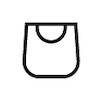
Like most people, you probably have a piece of furniture or two lying around the house that could use a makeover. And today I want to show you how easy it can be for you to make it happen.
Over the years some of my favorite projects have been when I am able to upcycle the furniture around my own home!! From custom dining room chairs for my two kiddos, to the living room coffee table and our nightstands, I have re-done a lot of the furniture around our house.

The photo above is the Coffee Table makeover I did! I created a wonderful textured surface to the top using the Crocodile Roller and people have loved it. To learn more about this makeover, click here!
A project like the one above can seem a little daunting if you are just getting started with creating textured surface projects. But, today I want to show you truly how easy it can be to make your furniture to die for!
Creating A Textured Surface
Texture Medium Application
So… What is Texture Medium you ask? Texture Medium is a low VOC tintable plaster, or paste, that has a matte finish. I created this product to be used with Patterned Paint Rollers to create interesting textures and patterns on furniture, cabinetry, walls, and more.
To start, you will need a trowel or flat spatula. You could also use an old hotel key if you don’t have either of those.
Now, you will trowel on this marshmallow like paste to
 your project. You will want it to be a 1/16 to 1/8 of an inch, so make sure you keep it on the thinner side. It should look similar to this photo.
your project. You will want it to be a 1/16 to 1/8 of an inch, so make sure you keep it on the thinner side. It should look similar to this photo.
Rolling Through the Texture
Before you start “rolling”, you will want to make sure your Texture Roller is spinning “freely” on the handle. If it isn’t rolling perfectly, take the roller head off and spray the metal part of the handle with a little pam or any greaser you have lying around the house.
Once you are “freely” spinning, using your favorite Decorative Art Roller, you will roll through the Texture Medium to create your beautiful pattern.

If it doesn’t look exactly how you want it to, you can trowel back over and try again. But you have to remember that art isn’t perfect and that’s okay. Let your Texture Medium dry completely. This will take a couple of hours.
Sanding
Once your project is dry, you will see that some of the edges of the pattern will be slightly raised. We will want to knock those down with a little sanding.
Using 150 grit sandpaper and a sanding block you will want to sand down the “highs” and “peaks” of the Texture Medium. If you want the pattern to be a little more subtle you can sand more. 
Create the Finish You Desire
At this point, it’s up to you where you take the project, so use your imagination!
For the purposes of this post we will keep it simple and easy. I am going to show you how you can paint right over the textured surface and how to add some distressing.
Paint with DIY Paint
Let’s start with painting your project. You will want to paint on one complete layer of paint. Any paint will work just fine but I prefer to use chalk based paints!
My favorite Chalk Paint to use is Debbie’s Design Diaries DIY Paint. I have found this chalk paint to be great because it covers really well in one coat. Because we are going to distress this project, our painting doesn’t need to be perfect. Now you will need to allow the chalk paint to dry completely.

Distressing with Cheese Cloth

Once your project is dry, you are going to start the distressing process. You will create a little pad with the cloth and spray with some water. Cheesecloth is great because it has a little texture and will grab the pattern and remove some of the paint. This will bring the edges of the pattern out and expose them. How muchor how little you choose to distress is up to you! After you let it dry, you will see how the color changes considerably with chalk paint.

Waxing to Make the Finish Pop!
Next, you will need clear wax, a glove, and some cheesecloth. You will want to grab some of the wax out with the cheesecloth and then rub on a foam plate to get the wax into the cloth. Then once your cheesecloth is ready, you will rub the surface in a buffing motion.
You will want to keep it thin when applying so it dries properly. If you are looking to have a thicker wax profile you will want to do it layer by layer. Again, as the surface drys, it will lighten up slightly.
In the photo below you can see how well the wax and distressing have made the texture surface pop! (photo before fully dry)

Things You’ll Need:
- Fauxy Roller
- Texture Medium
- 150 Grit Sandpaper (affiliate link)
- Sand Block (affiliate link)
- DIY Paint
- Cheese Cloth
Final Thoughts
This is such a simple and easy technique that anyone can do no matter your skill level!
I hope this has inspired you to get creative and start using Texture Paint Rollers on your next project.
If you have any questions please feel free to reach out!



